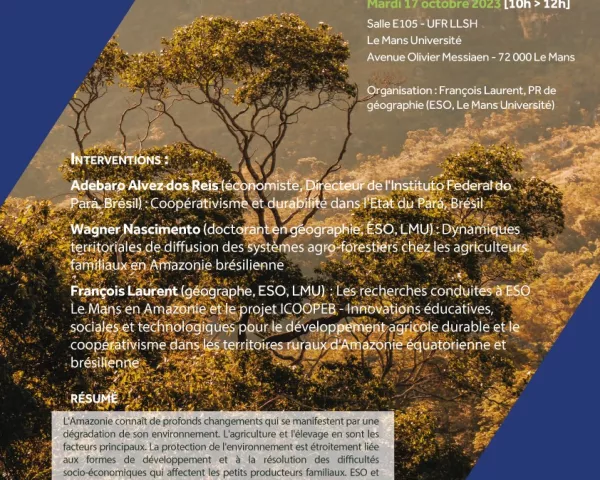Les derniers dépôts de Wagner Luiz Nascimento Do Nascimento
Desenvolvimento de sistemas agroflorestais nos territórios rurais da Amazônia

Ecole doctorale ED Sociétés, Temps, Territoires (STT)
Wagner Luiz Nascimento Do Nascimento. Desenvolvimento de sistemas agroflorestais nos territórios rurais da Amazônia. Geography. Le Mans Université; Instituto federal do Pará (Belém), 2024. Portuguese. ⟨NNT : 2024LEMA3009⟩. ⟨tel-04960704⟩
O debate sobre outras formas de fazer agricultura é necessário e urgente. As crises queassolam a sociedade destacam cada vez mais a importância da adaptação de práticas,técnicas e ferramentas para produzir nos territórios rurais da Amazônia. A agriculturafamiliar baseou-se durante séculos numa prática que consiste no corte e queima dafloresta, ligada à agricultura itinerante. Fatores recentes, como o crescimentopopulacional e a procura de alimentos, intensificaram as áreas de produção parasatisfazer a procura do mercado. Isto põe em perigo recursos naturais como a água, osolo e o ar. Repensar os métodos e sistemas de produção é um ponto chave paraalcançar uma agricultura familiar capaz de atender aos aspectos fundamentais dasustentabilidade. Nesse sentido, os sistemas agroflorestais (SAFs) são uma alternativaadotada pelos agricultores familiares na Amazônia, pois estão bem adaptados àsdiversas realidades da região, mas esses sistemas estão se espalhando lentamente.Assim, a presente pesquisa tem como objetivo identificar os aspectos relacionados àsbarreiras que impedem a adoção e/ou difusão do SAF na agricultura familiar e aspossíveis estratégias de adoção que possam contribuir para superá-las nos territóriosrurais da Amazônia. A pesquisa foi realizada nas áreas de várzea do Igarapé-Miri e nocontinente de Tomé-Açu, Amazônia Oriental, adotando uma abordagem de pesquisaquali-quantitativa, com fins exploratórios e descritivos. Ao final da pesquisa, comoprincipais resultados, identificamos que a pesquisa sobre SAF tem se concentrado emum debate mais socioambiental, enquanto as principais barreiras identificadas tanto nonível da propriedade quanto nos multiníveis espaciais Local/Territorial eRegional/Federal, o os factores que limitam a adopção do SAF estão ligados a factoressocioeconómicos. Outro resultado é considerar tanto as especificidades do ambientebiofísico para estruturar esses sistemas quanto as técnicas utilizadas para implementálos,considerando diversos aspectos das fazendas como disponibilidade de mão de obra,recursos financeiros, tempo, materiais, insumos, entre outros. Por fim, outro resultadoextremamente importante que identificamos está ligado às relações de cooperação e àcriação de redes no território: revelam-se elementos estratégicos e fundamentais parasuperar as barreiras encontradas e assim apoiar os agricultores familiares na transiçãoagroecológica.
The debate on other ways of farming is necessary and urgent. The crises that areravaging society increasingly highlight the importance of adapting practices, techniquesand tools to produce in rural areas of the Amazon. For centuries, family farming hasbeen based on a practice that consists of cutting and burning the forest, linked toitinerant agriculture. Recent factors, such as population growth and the demand forfood, have increased the production areas to meet market demand. This endangersnatural resources such as water, soil and air. Rethinking production methods andsystems is a key point to achieve family farming capable of meeting the fundamentalaspects of sustainability. In this sense, agroforestry systems (AFS) are an alternativeadopted by family farmers in the Amazon, as they are well adapted to the diverserealities of the region, but these systems are spreading slowly. Thus, the presentresearch aims to identify the aspects related to the barriers that prevent the adoptionand/or diffusion of AFS in family farming and the possible adoption strategies that cancontribute to overcoming them in rural areas of the Amazon. The research wasconducted in the floodplain areas of Igarapé-Miri and on the mainland of Tomé-Açu,Eastern Amazon, adopting a qualitative-quantitative research approach, withexploratory and descriptive purposes. At the end of the research, as main results, weidentified that research on SAF has focused on a more socio-environmental debate,while the main barriers identified both at the property level and at the multi-level spatiallevels Local/Territorial and Regional/Federal, the factors that limit the adoption of SAFare linked to socioeconomic factors. Another result is to consider both the specificitiesof the biophysical environment to structure these systems and the techniques used toimplement them, considering various aspects of the farms such as availability of labor,financial resources, time, materials, inputs, among others. Finally, another extremelyimportant result that we identified is linked to cooperation relationships and the creationof networks in the territory: they reveal strategic and fundamental elements to overcomethe barriers encountered and thus support family farmers in the agroecologicaltransition.












